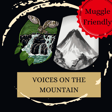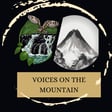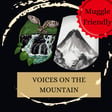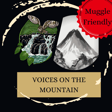Become a Creator today!Start creating today - Share your story with the world!
Start for free
00:00:00
00:00:01

ACL Injuries
The World Cup gets everyone focused on football, female athletes and this year ACL injuries. We join the trend and look into ACL tears with a TCM outlook.
Transcript
ACL Injuries in Female Athletes: A Growing Concern
00:00:10
Speaker
This week with voices on the mountain we're going to talk about ACL injuries and female
00:00:16
Speaker
athletes. There's a lot of things in the newspaper right now as the World Cup is coming up. And I've seen a couple of almost like the same articles about how often and how common ACL injuries are for female athletes. Steven, what do we got to say about this? You bet, Asher. Also fitting for voices from the mountain talking about potentially knee injuries going up and down a mountain.
00:00:41
Speaker
connection. Oh, yeah, you betcha man. So like, yeah, I think there's, there's some straight up like just societal stuff like, you know, they talked about, I've read some stuff about how the the cleats aren't really fitting for females.
Anatomical and Societal Factors in ACL Injuries
00:00:55
Speaker
There also is, you know,
00:00:57
Speaker
the anatomical differences of generally ladies have slightly wider hips. And so how is that putting extra tension on the tendons and just trigonometry wise, how that's tweaking things. But you're exactly right, man. The first and foremost thing that we would talk about here would be the cycle, which would be liver blood and also really key stagnation. So a lot of research has shown that there's actually a greater incidence rate of ACL injuries for women right before their ovulation.
00:01:25
Speaker
And that is a classic time for what we call Dreyin or liver cheese stagnation. Now the whole cycle isn't Dreyin liver stuff, but the ovulation 100% is. And the injuries during that time were right before ovulation. Is the body spending more of its liver blood in the ovulation process or is it just getting stagnated there?
Menstruation, Ovulation, and Injury Prevention
00:01:51
Speaker
I love it. Yeah, because you bring up the both parts, the stagnation plus the deficiency. The deficiency is actually stemming from the cycle that just happened 12 days before. Usually we think of maybe day 12 to day 15, 16 as that window. Obviously you can do it right on day 14 for the actual ovulation, but to get the whole ovulation process going, we usually give it a day or two on either side.
00:02:13
Speaker
And that first you know once the cycle ends usually around a six day seven something like that that's like the key time for women to rebuild blood everybody needs to do it you know if you know if a man was hiking a lot and skin Disney really bad every month to ensure you need to rebuild blood but,
00:02:31
Speaker
we just don't lose as much as women do and so they sometimes forget that that beginning part is really the key window and you gotta do it right away like day six day seven really start nourishing that blood because by the time you get to day twelve you don't want to over nourish because that's where you gotta start moving and so really you can liken this to lots of things but the shanghun cycle is one big one
00:02:53
Speaker
So, when we talk about the Shang Han Lun cycle, we've got Taeyang to the outside, Yang Ming to the inside, relatively, and Shaoyang in the middle. I know there's a little bit of controversy out there. Shout out to all you Shang Han Lun nerds, but there really should not be. There's no other place for the Shaoyang to be. Also, in no way was Steven saying that a woman's period is like a man scraping his knee on a mountain.
00:03:16
Speaker
That is not what he was saying. I was just talking about monthly blood loss. You know what's really funny though, dude? I think they just chopped up. Yeah, it's fine. But what's so funny when you study herbs is, no doubt, a lot of the herbs we use for treating gynecological menstruation stuff are the exact same herbs we'd give men for broken ribs, bruises, trauma,
00:03:41
Speaker
Like when guys aren't a little empathetic about female cycles, maybe they should go and get in a fistfight every month and see we're using the exact same formula. It's hilarious. Well, maybe that him going out and getting in that brawl is part of his cycle.
Herbal and Acupuncture Treatments for Injury Prevention
00:04:00
Speaker
Well, yeah, it's true. Yeah, for sure. We would usually correlate men's cycles more to yearly cycles because year is young.
00:04:09
Speaker
the day and the year generated via the movement of the sun, so they're all based on yang, but the movement of the moon, which is the female cycles entirely. So I always like to tell people, nighttime isn't technically a yin time, it's just a less yang time. It's basically the absence of the sun that creates that nighttime. It's not birthing of darkness.
00:04:31
Speaker
Oh, sure. Okay. Just like there is no yang time on a women's cycle, there's just a slightly yang year time, if that makes sense. It's all purely based on yin. It's all about the based on the moon, but at the full moon, it's the quote unquote yang-est time of that yin thing. But it's literally just like the sun, which is pure yang, reflecting off of the moon, which is pure yin, which just means you can see the whole moon and hence yang year, but it's still totally a yin cycle.
00:04:59
Speaker
In the woman cycle, the younger your time is during her flow? Actually, the younger time is ovulation. That's the youngest.
00:05:06
Speaker
That's the youngest of the yin. That's right. So when it comes to the female cycle, because it's purely yin, we can really correlate the three yin channels with this. So tai yin, dre yin, shao yin. And what you think about is, well, right after menstruation, let's build that blood. But when we think about what really builds blood, it's not the heart. It's tai yin. It's tai yin all the way, man. You've got to build it through the spleen.
00:05:34
Speaker
you know, half of the cycle is basically tied in. And then the middle part, right around ablation, day or two on either side.
00:05:42
Speaker
and then that last part, shaoyin. And how do we correlate this to the shaoyin? Just like shaoyang is the hub between the inner and outer yang, which is yangming to the inside, taiyang to the outside. Shaoyang is actually the hub between the yang layers. It's not the hub between yin and yang. That's a huge shaoyin drop right there. But then for the yin layers, there must be something to correlate and connect the yin layers.
00:06:09
Speaker
that's called zhui yin. So zhui yin is the hub between tai yin to the relative outside and xiao yin to truly to the inside. Huh, that's so interesting because I think in my mind I've just used xiao yin as the pivot in between the two yins as it mimics. And then also I can't think of what diagram is coming to my head that has the tai yang to xiao yang, yang ming, and then tai yin and then xiao yin.
00:06:39
Speaker
and then ending with Zhuayin before Zhuayin turns into Taeyang. Yeah, it's an interesting one. And then if you're trying to think about a cycle, well, some people will say it follows the daytime and nighttime cycles. That's actually not very, there's not a lot of evidence for that. Nijing doesn't talk about there being three periods of the day. They just say the entire daytime is controlled by Taeyang. And they say the entire nighttime is controlled by Taeyin. That makes it so much more simple. I mean,
00:07:07
Speaker
It's so interesting because people are like, oh, well, the six channel or six confirmation or six layer, or just let's use the Chinese word, the six jing from the shanghun. That's to correlate and mimic the time in the day.
00:07:20
Speaker
Maybe, but it's not Taoyang to raise Yang Ming as the brightest time and then Xiaoyang to descend. That's not correct. I really think people need to see that it's not that. If anything, it's Taoyang to lift in the morning, Xiaoyang right around noon to pivot as the hub point to get us to the descending of Yang Ming in the afternoon. And that's why it's the hub between the Yangs. It's not the hub between all the Yang and all the Yin.
00:07:48
Speaker
So, joint is going to be our pivot for the yins. Correct. It's going to happen during ovulation. Correct. Which really heightens that idea of the liver blood during ovulation time. Hence why female athletes would be getting more tendon ligament injuries during their ovulation time. You bet.
00:08:11
Speaker
And this gets us to the, this is an interesting Chinese medicine idea that if we're talking about movement, we're usually thinking about yang stuff. So we're saying, okay, well, I want to move liver chile, that's a yang thing, it's a yang function. But what allows the yang function? It's true, no stagnation is one, and that's still in the realm of the yang. But not only that, it's actually the yin stuff. So this is kind of the idea that if you don't have the firewood, you can't light the fire.
00:08:37
Speaker
the yin does propel the yang function. And so here we would say, okay, well, what's the body of the liver? And that's what we call the liver yin, two parts, one part blood, one part yin nutritive. And so you can see this very clearly for herbalists. So herbalists, we got danggui for the blood, 100% blood,
00:08:59
Speaker
bai sha for the yin nutritive layer. So those are both parts of the liver yin and then what would we use for circulating the liver yang? Good old chai hu. So that key trio there that so many people are using and so by far the most commonly used formula and probably the
00:09:16
Speaker
Entire country over here is Xiaozan, and it's got that trio for a reason. But the key is, they're not really remembering when to use this trio versus, say, a Xiaochai Hutong versus a Chaochu Ganzan. There's a real big reason why we'd be shifting that trio and shifting those ratios. We'll get into that later. But the key here is, what I like to tell people is, two parts, two herbs in there are for liver yin.
00:09:39
Speaker
One urban there is for liver young. It's so clear that what we need is really robust blood and fluids, which we know as you know, as Asher's point out, athletes run pretty hard, especially these like pro athletes and top notch athletes, quite likely they're over sweating, quite likely they're not nourishing up after their periods. In fact, a lot of them don't even have periods anymore if their body fat gets really low.
00:10:03
Speaker
And then you can imagine what you do when you're going into an activating time where you need to be able to move that liver yang, but you don't have any liver yin to do it, stuck. And that's the deficiency leading to the blockage. There is also the idea of, and then that could lead to an actual break in the tissue of the liver, the sinews, or we would also see the stagnation leading to it.
00:10:27
Speaker
So you'd see this with women that have a lot of maybe PCOS, any sort of cystic stuff on their ovaries, women that would feel ovulation. So most women, a lot of women don't even feel ovulation and some of them will feel really bloated, really full. Some of them will literally feel the pop when it ovulates. And so any of those people, they're going to be prone to stagnation. And what happens with stagnation, stuff's not getting where it needs to go. So that's the excess cause of the ACL tears.
00:10:56
Speaker
And then the blood and the inside side would be the deficient side of it. Nice. I hadn't connected the excess side, especially with the PCOS and stuff like that. It's very insightful. Uh, wrapping back to some of the other things they talked about in these articles, they mentioned the foot thing. I thought that was interesting. Sure. We have different feet, but also consider the types of shoes that we wear when we're not in our athletic wear.
00:11:21
Speaker
They were looking at, oh, cleats were based off of male feet, and we'd just been sticking women's feet in there. I'd also look at, I mean, I had a high school coach that made the female students wear high heels the day of their games.
Footwear and Pelvis Alignment: Impact on ACL Injuries
00:11:35
Speaker
And one, it was kind of rough to watch all these really high functioning athletes struggle to walk around in heels all day. But the other thing too is that the heels are gonna shorten the calf muscles, and that's gonna have a whole different dynamic on the way that they play and the loads and pressures throughout the body.
00:11:51
Speaker
Another thing I thought was interesting was that these were ACL tears that we're talking about. And now they're common for a couple of different reasons, but I thought, Oh, no coincidence that, you know, it's, it's in the knee where all these yen channels go deeper. It's where the tonifying point, if you were going to, you know, tonify a woman for her liver blood, you might pick the hussy point right there on, on that knee. So I thought no coincidence there as well.
00:12:20
Speaker
Yeah, you bet man. So such a good point about the high heels too. Especially any sort of interior tears, damage or even just pain spots on the like below or above the patella on the front side there. We always tend to look at the musculature on the back. And that's just because of the tendon structure of that knee. So a lot of if there's ever pain on the top or the bottom of the front side, we'll tend to look at either the hamstring or the calf for extra tightness.
00:12:47
Speaker
Because I always describe it as basically a suspension bridge. The knee is just a suspension bridge that is literally like almost all four directions and dimensions.
00:12:57
Speaker
But you can think of if you visualize someone's leg with toes pointed up, maybe they're sitting down doing a runner stretch. Then when it goes top to bottom from the front shin down to the back of the hamstring, also from the back of the calf up to the top of the quad, and you get these kind of crossing patterns. And that's just based on how the tendons work and everything else. But because it's such a shallow joint,
00:13:23
Speaker
It really relies on equal tension on both sides of the suspension bridge. Otherwise, it's going to start pulling the joint forward a little bit back a little bit, which doesn't sound like a huge deal until you're running at whatever crazy speeds these people are running at. And then you're just going to be grinding on the meniscus and the labrum and just setting the whole system off kilter. Totally. And specifically, even more than just the top speed might be the change of direction, the quick changes, the slowing down of one way, the explosion another way.
00:13:52
Speaker
is going to put pressure and torque on the body in pretty unique ways and stress out the weakest parts. I'll just say a quick hit for the pelvis, too, while we're talking about all this because the pelvis has a huge effect over how the thighs and all the muscles in there are aligned and working back down to that same knee. If the pelvis is anteriorly rotated,
00:14:17
Speaker
then the foot's going to have a hard time and the knee is going to have a hard time staying in place without having other things lock up. So true, dude. So true. And that's, um, that ties into why we use the yin chow and yang chow vessels. Because, yeah. And some people, I think they translate that in English as the heel vessel. Is that right, Asher? Yeah. They'll, I just know it as the walking vessel. Cause I feel like that's a better translation. Exactly. Exactly.
00:14:46
Speaker
So I've heard heal vessel. I've heard there's another one that you use. There's one activity. There's like a activity vessel. Yeah. For, yeah, you're talking about the young chow. So, Oh, maybe I'm mixing this up and this is just what they say. But I've heard the young chow is for like the awake, the active mind and the yin chow is for like sleeping opposite. Yeah. And then you can use these two for, for insomnia.
00:15:16
Speaker
Yep, that's absolutely right. That's absolutely right.
00:15:18
Speaker
And they're the only channels, unless you count the di-channel, which is just kind of wacky all by itself. But it's the only more longitudinal channels that are really crossing the body. And then, of course, there is the wee little cross of the large intestine channel, but it doesn't cross all the way over. It just crosses right there at Ringel. But these are the major ones that are actually correlating left and right side of our bodies. And therefore, so key for, like you said, walking vessels is a pretty good one. It's not a heel vessel. It's just emanating starting from the heel.
00:15:48
Speaker
Linking or bridging vessel might be the other way that they translate that. All of them have some element to it, but the key is it's correlating our left side and our right side. So huge for motor function and especially movement. So when people are splaying at the hip or going the other way and kind of goose stepping it, you bet yin chow and yang chow or Dr. Guo always used that for regulating and shifting hip function.
00:16:14
Speaker
Nice. And is this opening up the master and couple point? Or is this using the points on that channel? Oh, that's a sweet one. We should do a whole podcast on this one, too. Those points, those eight... I don't know, whatever... So the eight channel confluence points, probably how they're translated. This one is... It's an interesting one because I've heard in America, they only do the pairs.
00:16:42
Speaker
that's not true that is not true when you pair them you get different functions that's true but you don't have to use them together and i know there's a whole left right thing that people do here and
00:16:53
Speaker
I don't know where that comes from. But the point is, is we use them, you know, like we'll pair the yin-wei-mai with the yin-cha-mai. What? Yin with yin? You bet. If we want to affect a throat, go there because that's where both of those extraordinary channels go. So we don't have to stick to the standard pairings. We'll delve deep in that later. Yeah, so big shout out. So yeah, you don't have to pair them together. You just use the ones that you need. But if you want the paired function, that's usually a different thing.
00:17:19
Speaker
Totally. The she cloth points of these vessels useful for treating these diseases? Yeah, it's a great point. So they're great for treating the blood and the pain, depending if it's a yin and yang channel. But I think you're right for nourishing, then we would usually tend to go elsewhere.
00:17:39
Speaker
So if it was a nourishment, we'd probably focus elsewhere. But if there was already the injury, you betcha.
Acupuncture's Role in ACL Injury Prevention
00:17:45
Speaker
C cleft is great. So if we wanted to kind of prevent this with, you know, that sort of thing. Also, if we wanted to circulate liver G, then we'd usually just go to some really key liver G moving points. Shout out to Chi Mun. Is that 14? Yeah. 14. Yeah.
00:18:00
Speaker
Oh man, Chi Minh. Well, I'll just give you guys a teaser. The name on that one is so useful. We'll get into that later. Chi gait. Well, it's different. That's a different Chi. This one's Chi as far as not Chi. Man, you could have fooled me. Load that whole statement up with, this point is really good for moving liver Chi stagnation. It's called Chi Minh, but it's not that Chi. Like, okay. Yeah. That's a good one.
00:18:27
Speaker
I went, I went through all this school too. Cause we've, we've talked about this point before too. And I didn't, didn't realize that it's not the same chief. We'll put it on our top five. We'll do a little series of, uh, herb names and why the, or acupoint names and why they're so, so, so key to know. But let's put that on our top five. We'll do like, maybe we know a little mini series on that. That and, uh, and all the corrections we have to do with, with our stuff over here, just going back to one of them.
00:18:53
Speaker
the extra ordinaries opening up the left and right side. I searched really hard trying to find anywhere that it's either written in Machocha or in any of the books that talk about that. And I came up short. I wasn't able to find anything. The only things I was able to come up with was
00:19:10
Speaker
you know, half of those master points are low points in and above themselves. So sometimes people use low points opposite their young counterpart if you're trying to do that kind of idea. So in that way it would make sense. And then really there was a Japanese, I don't know if he's a master or what his designation would be, but he was very well followed. And I think he was the one who came up with the ion pumping cords.
00:19:36
Speaker
And he would use opposite end for the vessels. So if he was going to use SI3 or Hoshi, and then the UB62, which now I just have it in my head as the ghost walking point. That's the Yangtiao point, right? Shenmai. Would do that on opposite and do them with iron cords. I see. That makes so much more sense. Thank you for explaining that to me, because I didn't know where the people were putting that in from.
00:20:06
Speaker
All right. So that was our short little episode on ACL tears. If you are a female athlete, go find an acupuncturist near you. We have the tools and the knowledge and background to help you out. Stay tuned for more on voices from the mountain.





